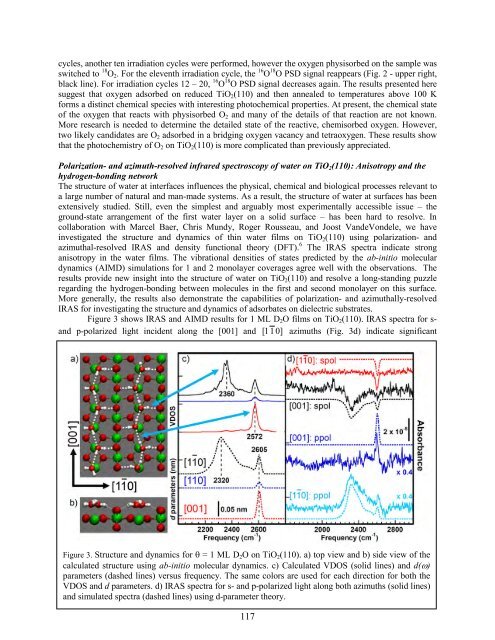Eighth Condensed Phase and Interfacial Molecular Science (CPIMS)
Eighth Condensed Phase and Interfacial Molecular Science (CPIMS)
Eighth Condensed Phase and Interfacial Molecular Science (CPIMS)
You also want an ePaper? Increase the reach of your titles
YUMPU automatically turns print PDFs into web optimized ePapers that Google loves.
cycles, another ten irradiation cycles were performed, however the oxygen physisorbed on the sample was<br />
switched to 18 O2. For the eleventh irradiation cycle, the 16 O 18 O PSD signal reappears (Fig. 2 - upper right,<br />
black line). For irradiation cycles 12 – 20, 16 O 18 O PSD signal decreases again. The results presented here<br />
suggest that oxygen adsorbed on reduced TiO2(110) <strong>and</strong> then annealed to temperatures above 100 K<br />
forms a distinct chemical species with interesting photochemical properties. At present, the chemical state<br />
of the oxygen that reacts with physisorbed O2 <strong>and</strong> many of the details of that reaction are not known.<br />
More research is needed to determine the detailed state of the reactive, chemisorbed oxygen. However,<br />
two likely c<strong>and</strong>idates are O2 adsorbed in a bridging oxygen vacancy <strong>and</strong> tetraoxygen. These results show<br />
that the photochemistry of O2 on TiO2(110) is more complicated than previously appreciated.<br />
Polarization- <strong>and</strong> azimuth-resolved infrared spectroscopy of water on TiO2(110): Anisotropy <strong>and</strong> the<br />
hydrogen-bonding network<br />
The structure of water at interfaces influences the physical, chemical <strong>and</strong> biological processes relevant to<br />
a large number of natural <strong>and</strong> man-made systems. As a result, the structure of water at surfaces has been<br />
extensively studied. Still, even the simplest <strong>and</strong> arguably most experimentally accessible issue – the<br />
ground-state arrangement of the first water layer on a solid surface – has been hard to resolve. In<br />
collaboration with Marcel Baer, Chris Mundy, Roger Rousseau, <strong>and</strong> Joost V<strong>and</strong>eVondele, we have<br />
investigated the structure <strong>and</strong> dynamics of thin water films on TiO2(110) using polarization- <strong>and</strong><br />
azimuthal-resolved IRAS <strong>and</strong> density functional theory (DFT). 6 The IRAS spectra indicate strong<br />
anisotropy in the water films. The vibrational densities of states predicted by the ab-initio molecular<br />
dynamics (AIMD) simulations for 1 <strong>and</strong> 2 monolayer coverages agree well with the observations. The<br />
results provide new insight into the structure of water on TiO2(110) <strong>and</strong> resolve a long-st<strong>and</strong>ing puzzle<br />
regarding the hydrogen-bonding between molecules in the first <strong>and</strong> second monolayer on this surface.<br />
More generally, the results also demonstrate the capabilities of polarization- <strong>and</strong> azimuthally-resolved<br />
IRAS for investigating the structure <strong>and</strong> dynamics of adsorbates on dielectric substrates.<br />
Figure 3 shows IRAS <strong>and</strong> AIMD results for 1 ML D2O films on TiO2(110). IRAS spectra for s-<br />
<strong>and</strong> p-polarized light incident along the [001] <strong>and</strong> [ 11<br />
0]<br />
azimuths (Fig. 3d) indicate significant<br />
Figure 3. Structure <strong>and</strong> dynamics for θ = 1 ML D2O on TiO2(110). a) top view <strong>and</strong> b) side view of the<br />
calculated structure using ab-initio molecular dynamics. c) Calculated VDOS (solid lines) <strong>and</strong> d(ω)<br />
parameters (dashed lines) versus frequency. The same colors are used for each direction for both the<br />
VDOS <strong>and</strong> d parameters. d) IRAS spectra for s- <strong>and</strong> p-polarized light along both azimuths (solid lines)<br />
<strong>and</strong> simulated spectra (dashed lines) using d-parameter theory.<br />
117
















